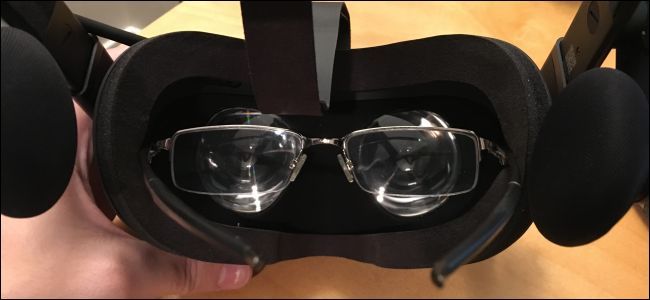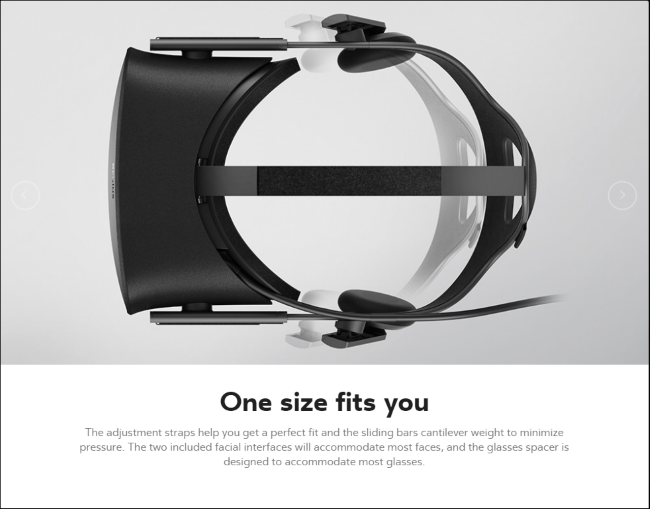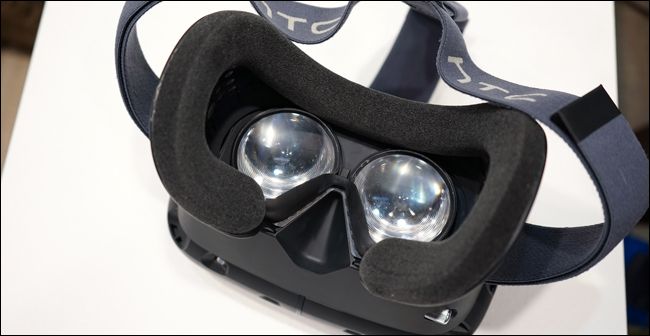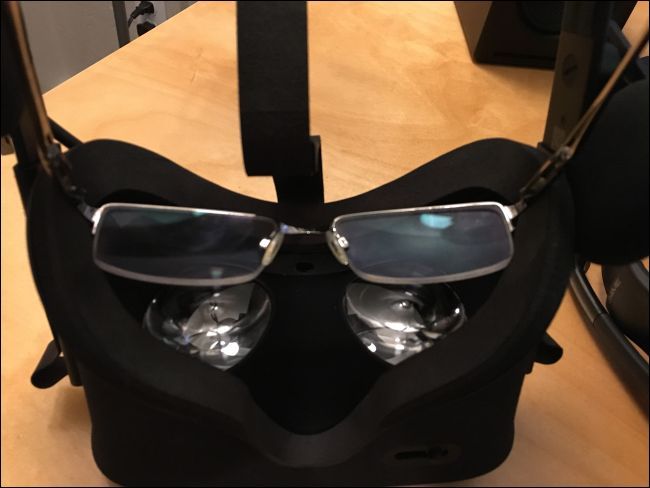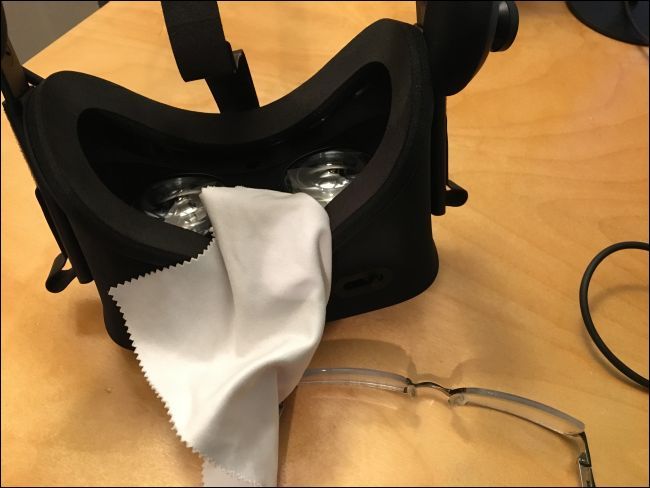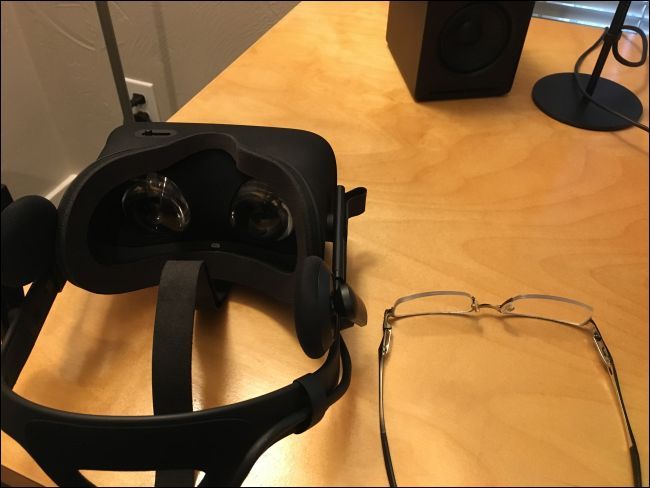Quick Links
The Oculus Rift and HTC Vive virtual reality headsets sit over your eyes, and glasses can get in the way. You can use some pairs of glasses with the Oculus Rift and HTC Vive, but you may want to measure your glasses before you buy a headset.
The Oculus Rift Doesn't Ship With the Promised Glasses Spacer
Oculus originally promised the Rift would include hardware designed for glasses. "One size fits you," read the promotional site...before it was removed. "The two included facial interfaces will accommodate most faces, and the glasses spacer is designed to accommodate most glasses," it said. But open an Oculus Rift box and you'll just find the headset comes with a single facial interface with no glasses spacer.
Other companies can make replacement facial interfaces that may better fit glasses, and those could be swapped into the Rift. But we're not aware of any company actually shipping a replacement facial interface designed for glasses yet.
The HTC Vive Has Two Different Face Masks
The HTC Vive, on the other hand, includes two different face masks, which you can swap back and forth. One provides more padding and one provides more space. There's still no guarantee either will work, but at least it's something.
Your Glasses Must Be Small Enough
You can measure your glasses before you spend hundreds of dollars on a headset and have a much better idea of whether your glasses will actually fit.
For the Oculus Rift, you'll need a frame width of 142mm or less, and a frame height of 50mm or less, according to the Oculus website.
For the HTC Vive, HTC's website simply says that "most glasses fit inside the headset". While HTC doesn't officially provide specific measurements, CNET reports that the frame must be no larger than 6 inches wide and 2 inches tall.
How to Put on an Oculus Rift or HTC Vive While Wearing Glasses
If you already have a headset, you can see if your glasses will fit. First, make sure your glasses frame actually fits in the headset when you're not wearing it. There's no point in trying to force it onto your head while wearing glasses if the glasses themselves won't even fit.
Be very careful that no part of the frame scratches the lenses inside your headset!
If your glasses do fit, loosen the headset's straps and place it on your head front-to-back, carefully positioning the headset over your glasses to make sure they fit. It may be a tight fit, and the glasses may end up stuck between the foam padding. This is probably fine, as long as there isn't too much pressure on them.
If you're using an Oculus Rift, that's all you can do. If you're using an HTC Vive, there are a few more adjustments that can help. Your HTC Vive comes with two face pads--try using the smaller face pad, which will give the headset more room for glasses.
The HTC Vive also allows you to adjust the lens depth, moving the lenses built into the headset a bit further from your face to allow room for your glasses. Locate the gray plastic rings at the sides of your headset, pull them out a bit, and then twist them both at once to move the lenses further away from your space. Push the rings back into the headset when you're happy with the lens distance.
Don't Forget to Keep Things Clean
You now have two sets of lenses to keep clean and smudge-free--the ones on your glasses, and the lenses inside the headset itself. Smudges may appear if the two sets of lenses rub together.
Remember, the lenses inside the headset should never be cleaned with any sort of cleaning solution. But, assuming you don't need a cleaning solution to clean your glasses, you can wipe both your glasses and the lenses inside the headset with the same dry microfiber cloth--be sure it's a microfiber cloth--to clean them.
You May Not Even Need Your Glasses
If your eyesight isn't too bad, there's a good chance you may not need glasses--even if you wear them throughout the day. Many people with weaker prescriptions report that they can use these headsets with no glasses and the picture is as good, or about as good, as it would be with contacts. This won't work for people who need stronger prescriptions. But, if you already have a headset, give it a try even if your glasses don't fit.
Anecdotally, I'm able to use my Oculus Rift just fine without glasses--and I have to, because my glasses don't really fit properly. It would probably be a tad better if I could use glasses, but it works well enough.
If All Else Fails: Try Contacts, or Wait
If your glasses don't fit, you're out of luck--you just plain can't use your glasses with the headset. Here's the real answer that should work for many people: Contacts. Even if you aren't in the habit of using contacts throughout the day, you can get contacts and put them in when you want to use your VR headset.
Unfortunately, these are the kind of issues and teething pains we usually see in first generation products. Virtual reality headsets are now a consumer product, but this is still version 1.0. We don't know why Oculus shelved the glasses spacer, since they removed their promise without official comment. But it's common for companies to do things like this just to just get the hardware out the door.
Oculus, HTC, and other companies will continue working in the hardware and the next generation of headsets may be more comfortable and adjustable for people who wear glasses.
The industry is working on other solutions, too, like third-party facial interfaces with more space for glasses. One company named VR Lens Lab promises to create prescription lens inserts that you can insert into your Oculus Rift or HTC Vive without the hassle of glasses, although we haven't tested this service. Perhaps this will be the real long-term solution instead of expecting every headset to accommodate bulky glasses. In the meantime, VR headsets need more development time to iron out all these kinks.
Image Credit: TechStage/Flickr.

